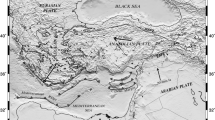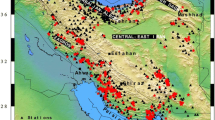Abstract
In this study, seismic moment, moment magnitude, and the corner frequency of Iranian earthquakes were estimated using the Iran Strong Motion Network (ISMN) data. To estimate the source parameters, Andrews (1986) method in frequency domain is employed. In this study, two horizontal components of the recordings were processed, filtered, and corrected for geometrical spreading and intrinsic attenuation and then have been used in source spectrum calculation. Here, two time windows were selected (1: S-wave and 2: from P- to end of S- window) and the results show that both windows provide acceptable results with similar mean residuals and standard deviations. However, the smallest standard deviation is related to S-window. In total, the moment magnitude for about 4171 records have been calculated. We validated our results for 209 earthquakes with at least three recorded accelerograms that had available reported moment magnitude. The results indicated that the estimated magnitudes are in good accordance with the reported moment magnitudes with mean residual of about 0.07 and standard deviation of about 0.2. This method can be employed in real time or near real time procedure, where both seismic moment and moment magnitude can be calculated soon after the earthquake originated just using available strong motion data. This information would be very helpful in crisis management so that more effective emergency response and recovery plan can be provided in future earthquakes.






Similar content being viewed by others
Data availability
All strong motion records selected in this study were obtained from Iran Strong Motion Network (ISMN; https://doi.org/10.7914/SN/I1). Data can be obtained from ISMN portal at https://ismn.bhrc.ac.ir/ (last accessed June 2018). The Global Centroid Moment Tensor Project database was accessed using www.globalcmt.org/CMTsearch.html (last accessed on June 2018). Moment magnitude information from National Earthquake Information Center was searched using https://earthquake.usgs.gov/earthquakes/search/ (last accessed on June 2018). The information from Iran Seismological Center was obtained from http://irsc.ut.ac.ir/focal.php (last accessed on July 2018).
References
Aki K (1966) Generation and propagation of G waves from the Niigata earthquake of June 14, 1964. Part 2. Estimation of earthquake moment, released energy and stress-strain drop from G wave spectrum. Bull Earthq Res Inst 44:73–88
Aki K (1972) Earthquake mechanism. Tectonophysics 13:423–441
Aki K, Richards PG (1980) Quantitative seismology. W.H Freeman, San Francisco, California, p 932
Andrews DJ (1986) Objective determination of source parameters and similarity of earthquakes of different size. Maurice Ewing series, 6, American Geophysical Union, Geophysics Monograph, 37, Washington DC, 259–267
Boatwright J (1980) A spectral theory for circular seismic sources; simple estimates of source dimension, dynamic stress drop, and radiated seismic energy. Bull Seismol Soc Am 70:1–27
Bommer JJ, Pereira AM (1999) The effective duration of earthquake strong motion. J Earthq Eng 3(2):127–172
Boore D (1983) Stochastic simulation of high-frequency ground motions based on seismological models of the radiated spectra. Bull Seismol Soc Am 73(6):1865–1894
Boore DM, Boatwright J (1984) Average body-wave radiation coefficients. Bull Seism Soc Am 74:1615–1621
Boore DM, Campbell KW, Atkinson GM (2010) Determination of stress parameters for eight well-recorded earthquakes in eastern North America. Bull Seism Soc Am 100:1632–1645
Brune JN (1970) Tectonics stress and the spectra of seismic shear waves from earthquakes. J Geophys Res 75:4997–5009
Brune JN (1971) Correction. J Geophys Res 76:4997–5009
Caprio M, Lancieri M, Cua GB, Zollo A, Wiemer S (2011) An evolutionary approach to real-time moment magnitude estimation via inversion of displacement spectra. Geophys Res Lett 38:L02301. https://doi.org/10.1029/2010GL045403
Chin B, Aki K (1991) Simultaneous study of the source, path, and site effects on strong ground motion during the 1989 Loma Prieta Earthquake: a preliminary result on pervasive nonlinear site effects. Bull Seism Soc Am 81:1859–1884.
Davatgari FTM, Singh Bora S, Mirzaei N, Ghofrani H, Kazemian J (2021) Spectral models for seismological source parameters, path attenuation and site-effects in Alborz region of northern Iran. Geophys J Int 227:350–367. https://doi.org/10.1093/gji/ggab227
Di Bona M, Rovelli A (1988) Effects of the bandwidth limitation on stress drops estimated from integrals of the ground motion. Bull Seismol Soc Am 78(5):1818–1825
Edward B, Allmann B, Fäh D, Clinton J (2010) Automatic computation of moment magnitudes for small earthquakes and the scaling of local to moment magnitude. J Geophys Res 183:407–420
Gallo A, Costa G, Suhadolc P (2014) Near real-time automatic moment magnitude estimation. Bull Earthquake Eng 12:185–202. https://doi.org/10.1007/s10518-013-9565-x
Gou HA, lerner-Lam A, Hough SE (1992) Empirical Green’s function study of Loma Perieta aftershocks: evidence for fault zone complexity (abstract). Seimol Res Lett 63:76
Hanks TC, Kanamori H (1979) A moment magnitude scale. J Geophys Res 84:2348–2350. https://doi.org/10.1029/JB084iB05p02348
Herrmann RB, Kijko A (1983) Modeling some empirical vertical component Lg relations. Bull Seism Soc Am 73:157–171
Hwang RD, Wang JH, Huang BS, Chen KC, Huang WG, Chang TM, Chiu HC, Tsai CP (2001) Estimates of stress drop of the Chi-Chi, Taiwan, Earthquake of 20 September 1999 from near-field seismograms. Bull Seism Soc Am 91:1158–1166
Kanamori H (1977) The energy release in great earthquakes. J Geophys Res 82:1981–1987
Kanamori H (1983) Magnitude scale and quantification of earthquakes. Tectonophysics 93:185–199
Kikuchi M, Kanamori H (1991) Inversion of complex body waves—III. Bull Seism Soc Am 81:2335–2350
Parolai D, Bindi D, Durukal E, Grosser H, Milkereit C (2007) Source parameters and seismic moment-magnitude scaling for northwestern Turkey. Bull Seism Soc Am 97(2):655–660. https://doi.org/10.1785/0120060180
Richter CF (1935) An instrumental earthquake magnitude scale. Bull Seism Soc Am 25:1–32
Shahvar M, Zare M, Castellaro S (2013) A unified seismic catalog for the Iranian Plateau (1900–2011). Seismol Res Lett 84(2):233–249. https://doi.org/10.1785/0220120144
Shahvar M, Farzanegan E, Eshaghi A, Mirzaei H (2021) i1-net: the Iran Strong Motion Network. Seismo Res Lett 92(4):2100–2108. https://doi.org/10.1785/0220200417
Shoja-Taheri J, Naserieh D, Ghofrani H (2007) ML and MW scales in the Iranian plateau based on the strong-motion records. Bull Seism Soc Am 97(2):661–669. https://doi.org/10.1785/0120060132
Acknowledgements
We acknowledge the Plan and Budget organization and Ministry of Road and Housing for supporting the Iran Strong Motion project and providing the access to the strong motion data for scientist, students, and researchers. We also would like to appreciate two anonymous reviewers for their useful remarks and suggestions that have contributed to improve the manuscript.
Author information
Authors and Affiliations
Corresponding author
Ethics declarations
Conflict of interest
The authors declare no competing interests.
Additional information
Publisher's Note
Springer Nature remains neutral with regard to jurisdictional claims in published maps and institutional affiliations.
Highlights
1- Earthquake source parameters including seismic moment, moment magnitude, and the corner frequency were estimated for Iranian earthquakes using strong motion data. A large database of accelerograms (more than 4000) recorded by Iran Strong Motion Network has been used.
2- Andrews’s method that is based on Brune source model is used in frequency domain to calculate the moment magnitude. Two time windows were selected to be used in the analysis and the results were validated for 209 earthquakes that had reported moment magnitude. Results show good agreement between calculated and reported magnitudes for both selected windows.
3- The results suggest the use of this method and strong motion data for moment magnitude calculation for earthquakes that have not reported moment magnitudes. Also, the outcome of the implementation of this method in real time or near real time would be very helpful in crisis management after earthquake occurrences.
Rights and permissions
Springer Nature or its licensor holds exclusive rights to this article under a publishing agreement with the author(s) or other rightsholder(s); author self-archiving of the accepted manuscript version of this article is solely governed by the terms of such publishing agreement and applicable law.
About this article
Cite this article
Eshaghi, A., Aoudia, A., Shahvar, M.P. et al. Moment magnitude estimation using Iran strong motion data. J Seismol 26, 883–895 (2022). https://doi.org/10.1007/s10950-022-10107-7
Received:
Accepted:
Published:
Issue Date:
DOI: https://doi.org/10.1007/s10950-022-10107-7




